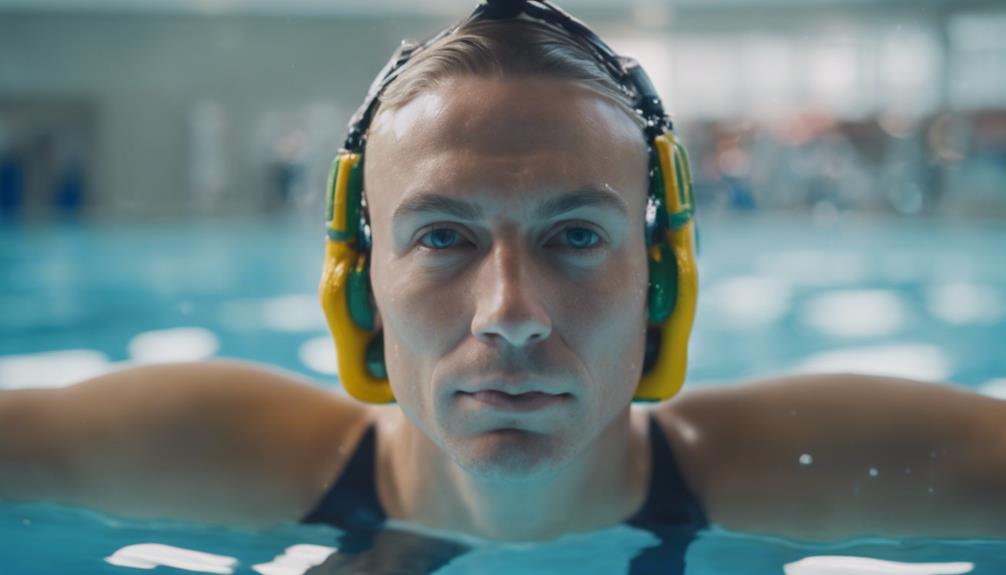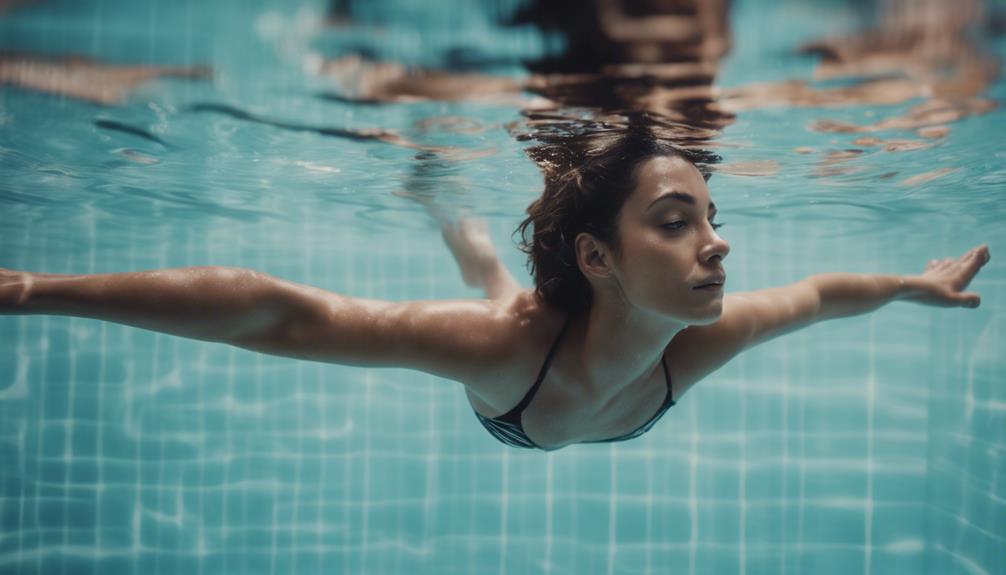In order to effortlessly float in a swimming pool, ensure that your arms and legs are spread out evenly to maintain balance. Align your head with your spine, roll back your shoulders, and tilt your head back in line with your spine. Take deep breaths to stay afloat, focusing on relaxing your muscles and engaging your core. Fully extend your limbs and keep your fingers above water to help with balance. Avoid holding your breath and tensing your muscles, as this can reduce buoyancy. It is crucial to understand proper body positioning and breathing techniques in order to stay stable and afloat in the water. Practice and master these techniques to float with ease in the pool.
Key Takeaways
- Spread out arms and legs for balance and weight distribution.
- Align head with spine for stability and buoyancy.
- Focus on proper posture and engage core muscles.
- Breathe deeply to maintain buoyancy and stability.
- Relax muscles consciously for an improved floating experience.
Spread Out for Balance
To achieve balance while floating in a swimming pool, make sure to spread out your arms and legs evenly to distribute your weight on the water. Learning how to float effectively involves spreading your limbs to maintain equilibrium. By following this tip, you can prevent uneven weight distribution that may cause you to tilt or sink in the water. Ensuring that your arms and legs are extended helps you stay afloat effortlessly.
When you spread out your limbs, you create a larger surface area that interacts with the water, enhancing your stability. This simple adjustment can make a significant difference in your ability to float comfortably. By mastering the technique of spreading out for balance, you can enjoy a more relaxing and secure floating experience in the pool.
Head Positioning for Buoyancy

Proper head positioning in the water is crucial for maintaining buoyancy and stability while floating in a swimming pool. To achieve ideal buoyancy and ensure a comfortable floating experience, consider the following:
- Align Your Head with Your Spine: Tilting your head back in line with your spine helps to keep your body aligned and prevents sinking while floating in water.
- Relax Your Neck Muscles: Proper head positioning allows you to relax your neck muscles and breathe more easily, enhancing your buoyancy in the water.
- Maintain a Neutral Position: Keeping your head in a neutral position, neither too high nor too low, contributes to a stable and comfortable floating experience.
- Avoid Incorrect Postures: Incorrect head positioning, such as looking down or tilting forward, can lead to imbalance and hinder your ability to float effortlessly.
Perfect Your Posture

Maintain correct posture while floating in a swimming pool by rolling your shoulders back and opening your chest. This position helps in improving buoyancy by keeping your body aligned on the water surface.
Tilt your head back in line with your spine to prevent sinking and enhance your float. Confirm your arms and legs are stretched out to evenly distribute your weight, aiding in better balance and stability while floating in water.
Engage your core muscles to further stabilize your body, allowing for a more controlled and effortless float. By incorporating these posture adjustments, you can maintain proper alignment, prevent sinking, and improve your overall buoyancy in the pool.
Remember to relax your muscles and take deep breaths to enhance buoyancy further and promote a more comfortable and enjoyable floating experience. Mastering the correct posture is key to maximizing your floating potential and ensuring a relaxing time in the pool.
Breathe Deeply for Support

When floating in a swimming pool, remember to breathe deeply for support. Inhaling deeply helps you stay buoyant and maintain stability in the water.
Relax With Deep Breaths
To enhance your floating experience in a swimming pool, start by relaxing with deep breaths. Deep breaths play a key role in promoting relaxation and aiding in controlled breathing techniques, allowing you to float effortlessly.
Here are a few tips to help you relax with deep breaths:
- Inhale slowly and deeply through your nose to fill your lungs completely.
- Exhale fully through your mouth to release tension and promote relaxation.
- Focus on your breath to maintain a steady rhythm while floating, aiding in balance on the water.
- Practice controlled breathing techniques to enhance your floating experience and build confidence in the water.
Find Calm Through Breathing
Relax and find calm through your breath by deeply inhaling for support while floating in the swimming pool. Deep breathing plays an important role in enhancing your relaxation and buoyancy while you float.
By taking deep breaths before you start floating, you can expand your lung capacity, which not only aids in buoyancy but also helps stabilize your position in the water.
The controlled breathing patterns you practice will support your body's natural buoyancy, making it easier for you to stay afloat effortlessly. Deep breaths promote a sense of calmness, reducing any anxiety or tension you may feel during your floating exercises.
Additionally, by practicing deep breathing techniques, you enhance the flow of oxygen in your body, leading to an overall improvement in relaxation and your floating experience.
Relax Muscles for Floating

To achieve a successful float, it's essential to ease into relaxation, releasing tension gently and finding calm stillness in your body. By allowing your muscles to relax, you can enhance your buoyancy and maintain a stable position in the water.
Remember that deep breathing and muscle relaxation techniques can work together to help you float effortlessly.
Ease Into Relaxation
Achieving ideal buoyancy while floating in a swimming pool greatly depends on completely relaxing your muscles. To ease into relaxation and enhance your floating experience, consider the following:
- Focus on consciously relaxing each muscle group in your body, starting from your toes and moving up to your shoulders and neck.
- Practice deep breathing exercises to help release any tension and promote a sense of calmness while in the water.
- Use visualization techniques to imagine yourself becoming lighter and more buoyant with each breath you take.
- Pay attention to any areas of stiffness or tightness in your body and make a conscious effort to let go of that tension to achieve a more effortless float.
Release Tension Gently
Gradually loosening your muscles is vital to releasing tension and improving your floating ability in a swimming pool. When you hold onto tension, it can impede your capacity to float effortlessly. By gently relaxing your muscles, you allow your body to achieve a more buoyant position in the water.
Tension in your muscles can counteract your efforts to stay afloat, so it's important to focus on gentle relaxation techniques to enhance your floating experience.
To prevent sinking and maintain stability on the water's surface, let go of stress and tightness in your body. Start by slowly loosening your muscles starting from your head down to your toes. This gradual relaxation not only improves your floating technique but also helps you feel more at ease and comfortable in the water.
Find Calm Stillness
Release the tension in your muscles completely to find calm stillness and float effortlessly in the water. Relaxing your muscles is essential for achieving a stable and buoyant float position. By letting go of any tightness, you can improve your ability to stay afloat and enjoy the sensation of weightlessness in the water.
Here are some tips to help you relax your muscles for the best floating experience:
- Focus on consciously releasing any tension you feel in your body.
- Practice deep breathing exercises to help calm your mind and relax your muscles.
- Engage in mindfulness techniques to promote a serene state of being while floating.
- Visualize yourself as light and buoyant, allowing your body to naturally rise to the surface of the water.
Keep Fingers Above Water

To maintain proper body alignment while floating in a swimming pool, make sure your fingers are kept above the water surface. By extending your fingers above the water, you can reduce drag, enhance buoyancy, and improve balance, helping prevent sinking during floating sessions.
This technique not only assists in balancing your body but also guarantees your hands are in a streamlined position, providing better control over your float. Keeping your fingers above water level is essential for effective floating and relaxation in the pool.
It may feel natural to let your fingers dip into the water, but by consciously keeping them above the surface, you can enhance your floating experience. Remember, the goal is to maintain a stable and relaxed float, and keeping your fingers above water plays a significant role in achieving this.
Troubleshooting: Why You Sink

When experiencing sinking while floating in a swimming pool, identifying the root causes is crucial for troubleshooting and improving your buoyancy. To address why you may be sinking, consider the following factors:
- Body Position: Confirm your head is aligned with your spine to maintain proper posture and prevent sinking.
- Relaxation: Tensed muscles can reduce buoyancy, so focus on staying relaxed to help stay afloat.
- Breathing Technique: Avoid holding your breath and practice proper breathing techniques to support buoyancy.
- Weight Distribution: Check for even weight distribution and ensure your limbs are fully extended to promote balance and prevent sinking.
Frequently Asked Questions
How to Float in a Pool for Beginners?
To float in a pool as a beginner, focus on distributing your weight evenly by lying on your back and extending your arms and legs. Keep your head tilted back in line with your spine to maintain balance.
Roll your shoulders back and open your chest to improve posture. Deep breathing with full lung capacity promotes relaxation and buoyancy.
How to Stay Afloat in a Swimming Pool?
To stay afloat in a swimming pool, focus on distributing your weight evenly by extending your arms and legs. Tilt your head back in line with your spine to prevent sinking. Additionally, keeping your lungs filled with air will help provide buoyancy. It can also be helpful to use the best floatation devices such as a kickboard or pool noodles to assist in staying afloat. These can provide additional support and make it easier to maintain proper body positioning in the water.
Maintain good posture, roll your shoulders back, and open your chest for stability. Breathe deeply to maximize lung capacity and buoyancy.
Relax your muscles to enhance floating. Remember these techniques to stay effortlessly afloat in the water.
Why Do I Sink When I Try to Float?
When you sink while trying to float, it may be due to incorrect body positioning, lack of relaxation, improper breathing, inadequate air in your lungs, or incorrect head alignment with the spine.
These factors can affect your buoyancy in the water and cause you to sink.
How to Float in Water While Swimming?
To float while swimming, position your body horizontally in the water, extending your arms and legs for balance. Keep your head aligned with your spine to prevent sinking.
Maintain good posture by rolling your shoulders back and expanding your chest. Breathe deeply to maximize buoyancy.
Relax your muscles to let your body naturally float. These techniques will help you stay afloat effortlessly while enjoying your time in the water.
Conclusion
To sum up, mastering the art of floating in a swimming pool requires proper technique and understanding of buoyancy. By spreading out for balance, maintaining the correct head positioning, perfecting your posture, breathing deeply for support, and relaxing your muscles, you can achieve a peaceful and effortless float.
Remember, even the most experienced swimmers may encounter challenges, but with practice and patience, you can overcome any obstacles and enjoy the serenity of floating in the water.










